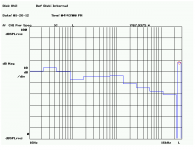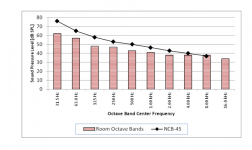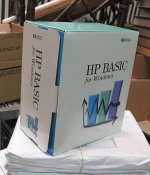Hello everyone.
I have an opportunity to get my hand on an Agilent 35670a for peanuts. Is it worth it for audio analysis and distortion? compared to more modern and affordable rigs (QA401 say). I'm not sure about noise floor and such. Any experience with this unit?
I'll be using it to test guitar tube amps (to check frequency response and play around with distortion), but I also plan on building HiFi tube amps in the near future.
What do you guys think? I really like standalone units
Cheers
I have an opportunity to get my hand on an Agilent 35670a for peanuts. Is it worth it for audio analysis and distortion? compared to more modern and affordable rigs (QA401 say). I'm not sure about noise floor and such. Any experience with this unit?
I'll be using it to test guitar tube amps (to check frequency response and play around with distortion), but I also plan on building HiFi tube amps in the near future.
What do you guys think? I really like standalone units
Cheers
Last edited:
Should be perfectly capable for valve amp circuits I would have thought, dynamic range is 90dB and 130dB for swept-sine. It should be an awesome addition to a home lab, but they are BIG and HEAVY. Unlike peanuts!
Hey Mark,
It is smaller than PC + audio interface through !
I was wondering about THD resolution on such a unit. And it is strange that I can't find on the internet any source or video on its application in audio testing... Which makes me hesitant
It is smaller than PC + audio interface through !
I was wondering about THD resolution on such a unit. And it is strange that I can't find on the internet any source or video on its application in audio testing... Which makes me hesitant
Its not really smaller than a laptop and a QA401. It more targets at vibration analysis. While you can do a lot with it HP/Keysight has the 8903D for audio. Unless its pretty cheap it would not be a better investment that even an older HP analyzer. A laptop's internal soundcard and a suitable attenuator may be adequate for many tube applications. Otherwise look at an HP 333, 334 or 339 or for more capability Amber, HP 8903, Boonton 1120, etc. Or the QA401 will get you answers without a lot of hassle.
The HP 35670A is a very solid piece of equipment. Before deciding on value for your application, you need to determine which options it has -- some would be desirable for audio and some wouldn't be that useful, though they wouldn't detract as you don't have to use them. I prefer my HP3562A but that's because I'm intimately familiar with it. For general audio frequency-domain work, either box would be OK.
I'm after a device with FFT and relatively good harmonic distortion resolution and low noise floor, beyond tube amp work (for the long run and for versatility). I know that the QA401 is the obvious answer, but as I said before, I like standalone units (kinda stems from nostalgia for vintage instruments).
The 35670a is quite smaller actually than older HP units, and very silent. It has an LCD screen, so no worries about a CRT dying on me.
What I can't seem to get is, considering its specs and dynamic range, how does it compare to an average modern rigs.
Brian, I will check the options
The 35670a is quite smaller actually than older HP units, and very silent. It has an LCD screen, so no worries about a CRT dying on me.
What I can't seem to get is, considering its specs and dynamic range, how does it compare to an average modern rigs.
Brian, I will check the options
I used the 35670A in college for amplifier characterization. I seem to recall it had an 80 dB dynamic range. Maybe 90 dB on a good day.
If I was in your shoes, I'd pick it up just to have it. At least I recall finding it handy for frequency response measurements and such. With an injection transformer, you can do loop analysis with it as well.
If your goal is to measure THD below -80 dB, you'll need something else. A good external sound card and some software will get you quite far.
Tom
If I was in your shoes, I'd pick it up just to have it. At least I recall finding it handy for frequency response measurements and such. With an injection transformer, you can do loop analysis with it as well.
If your goal is to measure THD below -80 dB, you'll need something else. A good external sound card and some software will get you quite far.
Tom
Thank you, this quite answers my question, as I don't understand FFT details very well (yet!). I guess down to 80-90dB THD is good enough for tube amps...
I will pick it up anyway. The owner got it for free as it didn't power up, it turned out to be a silly fault in the power supply, an easy fix, and offering it to me for a couple of hundreds euros. I can't refuse that !
I will pick it up anyway. The owner got it for free as it didn't power up, it turned out to be a silly fault in the power supply, an easy fix, and offering it to me for a couple of hundreds euros. I can't refuse that !
Last edited:
For a couple hundred Euros, that's a deal. Many of the options were software options. I don't recall if they were already in the box and just needed some secret code for activation, or whether they needed installation. But these days, who knows what you can find floating around the Internet.
I have had the 35670A and the Stanford Research equivalent SR780, now have the SR785. The SRS devices are much easier to work with if you have to program. All of these units were used for vibration analysis for companies like Caterpillar Tractor, Deere, General Motors, Pratt & Whitney, Ford etc. For audio you would be well advised to follow Demian's advice with the QA.
I have a 35670A and find it very useful. One thing you can also do with it is acoustical analysis with a calibrated microphone.
The 35670A had a very long run going all the way back to HP days and only being discontinued recently.
Weight is 33 pounds - heavy but not as obscene as some RF spectrum analyzers that weigh in at 45 to 50 pounds.
I find the user interface challenging - much more so than any other instrument I own. I always am sure to have the manual near by and I also write up any setup procedure I expect to use again.
With the latest firmware you can transfer files to a PC with an available Agilent/Keysight utility and a USB to GPIB interface - thus avoiding the need to use the floppy.
Options are stored in a small EEPROM - there may be further information about that on the www.
The 35670A had a very long run going all the way back to HP days and only being discontinued recently.
Weight is 33 pounds - heavy but not as obscene as some RF spectrum analyzers that weigh in at 45 to 50 pounds.
I find the user interface challenging - much more so than any other instrument I own. I always am sure to have the manual near by and I also write up any setup procedure I expect to use again.
With the latest firmware you can transfer files to a PC with an available Agilent/Keysight utility and a USB to GPIB interface - thus avoiding the need to use the floppy.
Options are stored in a small EEPROM - there may be further information about that on the www.
Just for example, here are two images showing SPL data acquired with the 35670A. One is a screen plot - the 35670A writes HPGH plotter language either to a plotter or to a file. Once you transfer the file to PC you can use John Miles tool to display the image.
Another method I use is to transfer the results to disk as numbers, then import into excel - here comparing the levels in a workplace to an NCB curve.
Another method I use is to transfer the results to disk as numbers, then import into excel - here comparing the levels in a workplace to an NCB curve.
Attachments
Hey xmo, thank you for this valuable input. Acoustical analysis would be a great addition indeed.
Here are the options installed :
- 1D1 : realtime octave measurements
- 1D2 : swept sine
- 1D4 : arbitrary source
- AY6 : 4 channels
- add 8 Mbytes memory
So it's lacking BASIC. The firmware is A.00.30 (it is from 2005)
The USB/GPIB cable is readily available on ebay. The one thing I'll be lacking is BASIC. I need to find out if Keysight still offers the upgrade, or if someone provides the upgrade.
Here are the options installed :
- 1D1 : realtime octave measurements
- 1D2 : swept sine
- 1D4 : arbitrary source
- AY6 : 4 channels
- add 8 Mbytes memory
So it's lacking BASIC. The firmware is A.00.30 (it is from 2005)
The USB/GPIB cable is readily available on ebay. The one thing I'll be lacking is BASIC. I need to find out if Keysight still offers the upgrade, or if someone provides the upgrade.
You can easily control it by sending commands from your computer once you have the USB->HP-IB in place. Purchasing IBASIC is not necessary for controlling it.
Hah! Lookie what I found. The old HP users group on Yahoo had a company guy who sold off their remaining copies of HP-Basic. The CD-ROM is unopened, and I can make an SD-RAM copy for anyone who cares (of course, you pay for the card and shipping.) It's for Windows95 or WinNT.
I don't have a 35670 anymore, only a 3577 (used fairly often for RF).
(Somewhere around here I have a program written for the 3577 which applied the RIAA curve by setting the amplitude at discrete frequencies).
I don't have a 35670 anymore, only a 3577 (used fairly often for RF).
(Somewhere around here I have a program written for the 3577 which applied the RIAA curve by setting the amplitude at discrete frequencies).
Attachments
That is a well equipped unit. The real time octave option will enable the acoustic measurements and the swept sine will give you enough dynamic range to do the frequency response and distortion tests.
BrianL is correct about the basic option. You would only need that if you wanted to write programs to run on the instrument which wouldn't make much sense given the power of today's PC's.
A.00.30 is the latest firmware so you wouldn't need to update the unit. It's amazing that you can get a such a good deal on a well equipped instrument.
There are a couple further thoughts that wouldn't be a concern for working on tube type guitar amps & such but could be for someone considering the 35670A for general audio test-bench applications.
There is only a single source output so it wouldn't be easy to drive both channels of a stereo amp. Also, the unbalanced grounded inputs won't bother a tube type amp with transformer output, but a lot of solid state amps won't tolerate that.
BrianL is correct about the basic option. You would only need that if you wanted to write programs to run on the instrument which wouldn't make much sense given the power of today's PC's.
A.00.30 is the latest firmware so you wouldn't need to update the unit. It's amazing that you can get a such a good deal on a well equipped instrument.
There are a couple further thoughts that wouldn't be a concern for working on tube type guitar amps & such but could be for someone considering the 35670A for general audio test-bench applications.
There is only a single source output so it wouldn't be easy to drive both channels of a stereo amp. Also, the unbalanced grounded inputs won't bother a tube type amp with transformer output, but a lot of solid state amps won't tolerate that.
Great infos
Yes it's an excellent deal, especially when you see the prices on ebay !!
Actually the BNC inputs don't bother me at all, since I am not used to balanced inputs anyway (being an electric guitar and tube amp lad). I will probably upgrade to another set up if I ever needed to later on.
jackinnj, I use windows 10 ! I ordered a Keysight USB/GPIB cable with instrument controle DVD suite on ebay
Yes it's an excellent deal, especially when you see the prices on ebay !!
Actually the BNC inputs don't bother me at all, since I am not used to balanced inputs anyway (being an electric guitar and tube amp lad). I will probably upgrade to another set up if I ever needed to later on.
jackinnj, I use windows 10 ! I ordered a Keysight USB/GPIB cable with instrument controle DVD suite on ebay
Is it possible to use microphones without the microphone adapter (UK4), i.e. through a mic preamp and into the normal channels?
I use a Behringer ECM8000 measurement microphone connected to an M-audio DMP3 preamp. The preamp powers the mic and the unbalanced output from the preamp goes right into the 35670A input. You will need a microphone calibrator to set the system up so the 35670A displays the correct SPL.
I have compared this arrangement to stand-alone sound level meters with excellent concurrence.
I have compared this arrangement to stand-alone sound level meters with excellent concurrence.
- Home
- Design & Build
- Equipment & Tools
- Agilent 35670a for audio analysis


